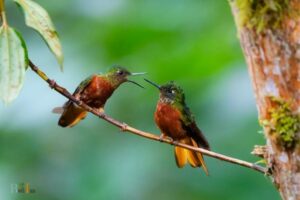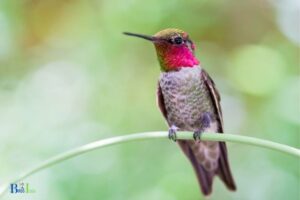How to Plant Hummingbird Vine Seeds? 10 Steps!
To plant hummingbird vine seeds, follow these steps: soak the seeds, prepare the soil, sow the seeds, maintain moisture, and await germination.
Hummingbird vines, also known as Trumpet Creeper or Campsis radicans, are vigorous climbing plants that produce clusters of trumpet-shaped flowers, attracting hummingbirds and other pollinators.
Planting hummingbird vine seeds is a cost-effective way to propagate these stunning plants in your garden.
Hummingbird vines are a fantastic addition to any garden, especially for those who enjoy observing wildlife such as hummingbirds and butterflies.
These vines grow rapidly, reaching up to 30 feet in length, and can thrive on trellises, fences, or arbors. The vibrant
Step-by-Step Plant Hummingbird Vine Seeds
| Step | Description |
|---|---|
| 1 | Soak the hummingbird vine seeds in water for 24 hours to soften the seed coat. |
| 2 | Prepare a well-draining potting mix in small pots or seed trays, making sure there are drainage holes at the bottom. |
| 3 | Plant the soaked seeds approximately 1/4 inch deep in the potting mix. |
| 4 | Place the pots or seed trays in a warm, sunny location with consistent temperatures between 70-75°F (21-24°C). |
| 5 | Keep the potting mix consistently moist but not waterlogged. Frequent, light watering is preferred over deep, less frequent watering. |
| 6 | Once the seeds have germinated, which should take about 2-3 weeks, continue to provide the seedlings with adequate light and water. |
| 7 | Begin the hardening off process when the seedlings have developed 2-3 sets of true leaves. Gradually expose the plants to outdoor conditions over a period of 1-2 weeks. |
| 8 | Choose a planting location for your hummingbird vine in full sun to partial shade, with support available for the vine to climb. |
| 9 | Plant the hummingbird vine seedlings in the ground, approximately 10-15 feet apart, ensuring the root ball is completely covered with soil. |
| 10 | Water the newly transplanted vines thoroughly, and continue to provide regular water and care as needed for optimal growth. |
Key Takeaway

Five Fascinating Facts About Hummingbird Vine Seeds
What You Need To Know About Hummingbird Vine Seeds
Are you looking to add a splash of color and attract hummingbirds to your outdoor space? Look no further than the hummingbird vine!
In this section, we’ll cover the basics of hummingbird vine seeds and what you need to know before planting them.
Explain What Hummingbird Vines Are And Their Importance To The Ecosystem
Hummingbird vines, also known as trumpet vines, are a type of flowering vine that produce trumpet-shaped blossoms in vibrant hues of orange, red, and yellow.
As the name suggests, these vines are a favorite of hummingbirds, making them an important addition to any ecosystem.
Hummingbirds rely on the nectar from flowers and, in return, serve as pollinators for the plant. This symbiotic relationship benefits both the hummingbirds and the plant.
Discuss The Benefits Of Planting Them In Your Garden Or Outdoor Space
Planting hummingbird vines in your garden or outdoor space can have numerous benefits beyond just attracting hummingbirds.
Here are some benefits of planting hummingbird vines:
- Adds a burst of color to your space
- Attracts other pollinators such as bees and butterflies
- Can help screen unsightly views or areas of your property you’d like to hide
- Can provide shade and cover for other plants and wildlife
- Low maintenance and easy to grow
Highlight The Different Types Of Hummingbird Vine Seeds Available And Which Ones Are Best For Your Area
Hummingbird vine seeds come in a variety of colors and variations, each with its own unique characteristics.
Here are some of the most popular types of hummingbird vine seeds:
- Trumpet creeper (campsis radicans) – a vigorous grower with orange-red trumpet-shaped flowers. Does well in warmer climates.
- Coral honeysuckle (lonicera sempervirens) – attractive to both hummingbirds and butterflies with clusters of orange-red flowers. Grows well in a range of climates.
- Scarlet runner bean (phaseolus coccineus) – a fast grower with clusters of bright red flowers. Does best in cooler climates.
- Cypress vine (ipomoea quamoclit) – a delicate vine with fern-like leaves and bright red flowers. Grows well in most climates.
When selecting hummingbird vine seeds for your area, it’s essential to choose a variety that is best suited for your climate. Consider factors such as temperature, humidity, and sun exposure when selecting your seeds.
Consult with a local gardening center or expert for advice on which hummingbird vine seeds are best for your area. Planting hummingbird vines can add beauty to your outdoor space while helping to promote a healthy ecosystem.
By following these simple steps and selecting the right hummingbird vine seeds for your area, you can enjoy the sight of colorful blossoms and happy hummingbirds for years to come!
Preparing The Soil
Planting hummingbird vine seeds can be a thrilling and satisfying activity for garden enthusiasts. However, before planting, it is crucial to ensure the soil is appropriately prepared for successful growth.
In this section, we’ll discuss the ideal soil conditions needed for planting hummingbird vine seeds, the importance of preparing soil before planting, and tips on how to prepare the soil for prosperous seed growth.
Discuss The Ideal Soil Conditions Needed For Planting Hummingbird Vine Seeds
Hummingbird vine seeds thrive in well-draining soil that is moist, fertile, and rich in organic matter. The soil’s ph level should be in the range of 6. 0 to 6. 5, slightly acidic. To make sure of the ideal soil consistency, conduct a soil test before planting.
Highlight The Importance Of Preparing The Soil Before Planting
Preparing the soil before planting hummingbird vine seeds is essential to ensure optimal growth. It allows the roots to spread swiftly and access nutrients with ease.
Moreover, soil preparation helps to avoid weeds, diseases, and pests from affecting the seedlings. Properly prepared soil will give you the best chance of success.
Provide Tips On How To Prepare The Soil For Successful Seed Growth
Here are some tips on how to prepare the soil for successful seed growth:
- Clear the area of any rocks, debris or weeds.
- Loosen the soil to a depth of 12-15 inches using a garden fork or a rototiller to improve soil drainage and root penetration.
- Mix in a generous amount of organic matter such as compost, manure, or leaf mould to enhance soil fertility and retain moisture.
- Level out the soil and create small trenches for planting.
- Water the soil generously, then add a layer of mulch to reduce weed growth and conserve moisture.
Preparing the soil before planting hummingbird vine seeds is a crucial factor in having successful growth.
Keep in mind the ideal soil conditions for these seeds, why preparation is vital, and the tips on how to prepare your soil for your thriving hummingbird vine.
Ensure to follow these guidelines to increase your chances of outstanding planting success.
Planting The Seeds
Once you have your hummingbird vine seeds, it’s time to start planting. Follow these tips to ensure optimal germination and growth.
Explain The Best Way To Plant Hummingbird Vine Seeds
Planting hummingbird vine seeds is simple and straightforward.
Here are the steps you should follow:
- Fill a seed tray or small pots with moist soil.
- Lightly press the seeds into the soil, making sure they are not buried too deep.
- Cover the seeds with a thin layer of soil, and gently press down again.
- Water the soil gently, being careful not to wash the seeds away.
Highlight The Importance Of Planting The Seeds At The Right Depth
Planting hummingbird vine seeds at the correct depth is crucial for successful germination. If they are planted too deep, the seeds may not receive enough oxygen or sunlight to grow.
On the other hand, if they are not buried deep enough, they may dry out quickly and die. The ideal depth for planting hummingbird vine seeds is around 1/8 inch.
This is roughly the size of the seed itself. To ensure that you are planting at the right depth, lightly press the seeds into the soil with your finger until they are covered, but not buried.
Provide Tips On How To Ensure Optimal Germination Of The Seeds
Hummingbird vine seeds can be temperamental, so it’s important to give them the right conditions for germination.
Here are some tips for successful growth:
- Keep the soil moist, but not waterlogged. Overwatering can cause the seeds to rot before they have a chance to sprout.
- Maintain a warm temperature. Hummingbird vine seeds prefer temperatures between 70 and 85 degrees fahrenheit.
- Provide plenty of light. Place the seed tray or pots in a warm, sunny spot, but out of direct sunlight to prevent the soil from drying out too quickly.
- Be patient. Hummingbird vine seeds can take several weeks to germinate, so don’t be discouraged if you don’t see any growth right away.
Following these simple tips will help ensure that your hummingbird vine seeds sprout and grow into healthy, beautiful plants.
Caring For Hummingbird Vine Seedlings
Ideal Conditions For Hummingbird Vine Seedlings
Hummingbird vine seedlings require specific conditions for healthy growth:
- Soil: The soil should be well-draining and moist, but not waterlogged.
- Temperature: The ideal temperature for seed germination is between 70-75°f (21-24°c). Seedlings should be kept in a warm, well-lit spot away from drafts.
- Light: Seedlings require bright, indirect sunlight to grow properly. Avoid exposing them to direct sunlight, as it may dry out the soil.
- Humidity: Humidity promotes healthy growth in seedlings. A humidity tray placed below the seedling containers can help increase humidity levels.
Proper care is essential for healthy growth of hummingbird vine seedlings.
- Watering: Water regularly but do not overwater. Soggy soil can lead to root rot, while dry soil will hamper growth. Check soil moisture regularly and water when the top inch of soil feels dry.
- Fertilizing: Feed the seedlings with a balanced liquid fertilizer once every two weeks to provide essential nutrients for growth.
- Providing support: Once the seedlings grow a few inches, provide support in the form of a trellis, stake, or cage. This will prevent the vine from sprawling and promote upward growth.
Identifying And Addressing Common Problems
Hummingbird vine seedlings may face common problems during the growth process.
Here’s how to identify and address these issues:
- Pests: Common pests include spider mites and aphids. Use insecticidal soap or neem oil to eliminate them.
- Fungal diseases: Hummingbird vines are prone to fungal diseases, such as powdery mildew and leaf spot. These diseases can be prevented by keeping the leaves dry and well-ventilated.
- Overfeeding: Overfeeding can lead to stunted growth and yellowed leaves, indicating a nutrient deficiency. Cut back on fertilizer and water the plant to flush out excess nutrients in the soil.
By following these basic guidelines, you can effectively care for your hummingbird vine seedlings and promote healthy growth.
FAQ On Hummingbird Vine Seeds
When Is The Best Time To Plant Hummingbird Vine Seeds?
How Do I Prepare The Soil For Planting Hummingbird Vine Seeds?
Do Hummingbird Vine Seeds Require Special Care?
How Long Does It Take For Hummingbird Vine Seeds To Germinate?
Can Hummingbird Vine Grow In Containers?
Conclusion
Planting hummingbird vine seeds is a simple and rewarding process. You just need to follow the right steps and provide the ideal growing conditions. Choose a spot with plenty of sunlight and well-draining soil, and make sure to keep the soil consistently moist.
Use a trellis or support system to help the vine climb and spread out. With some patience and care, you can expect to see blooms in as little as a few months. These stunning, trumpet-shaped flowers will attract hummingbirds and other pollinators to your garden, making it a beautiful and vibrant space.
So what are you waiting for? Get out there and start planting your very own hummingbird vine. Your garden (and the hummingbirds!) Will thank you for it.






